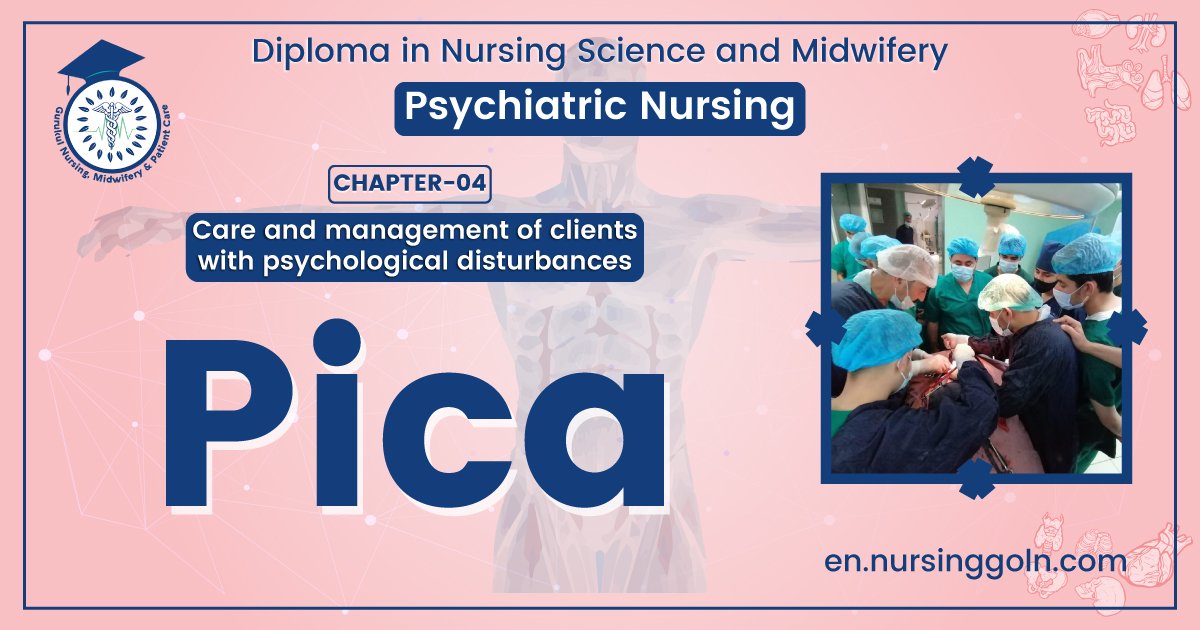Concept about Pica – This book covers the entire syllabus of “Psychiatric Nursing” prescribed by the Universities of Bangladesh- for Basic and diploma nursing students. We tried to accommodate the latest information and topics. This book is an examination-friendly setup according to the teachers’ lectures and examination questions.
At the end of the book previous university questions are given. We hope in touch with the book students’ knowledge will be upgraded and flourish. The unique way of presentation may make your reading of the book a pleasurable experience.

Concept about Pica
Pica:
The term, pica (Latm: magpie), refers to eating of substances other than food (nonedible items), eg earth, dust, clay, sand, flakes of paint, plaster from wall, fabrics, ice (pagophagia) etc.
[Ref-Suraj Gupte/1/54)
Or
Formulating the habit of eating non-nutritive or non-edible substances such as mud, dirt, wall plaster, chalk, paint, clay, etc. is called as ‘Pica’
Tasking or mouthing of strange objects is normal in infancy and children upto the age of 2 years. Persistence of this habit beyond the age of 2 years may be a behavioural manifestation. Pica is commonly observed in low socio-economic group and in malnourished, mentally sub-normal children
It is also seen among pregnant women.
Common age: I to 6 years.
Causes of pica:
1. Parental neglect
2. Poor supervision by the parents or elders in the family
3. Lack of affection
4. Strained interpersonal relationship among family members
5. Stressful situation or painful environment (hospitalization, entering to school)
6. History of neonatal insults.
(Ref: MR Khan/4/333+ KP Neeraja/T/Vol-2/504-505)
Clinical manifestations:
1 Child complaints of pain abdomen
2. Palior, anaemic
3 Slow in motor and mental development
4. Exhibit neurologie defects 5. Deviant behavior
6. Hystenc clients eat ash, salt, vmegar
7. Epileptic clients feel strong taste before attack
8 Schizophrenic client will have peculiar taste at certain times
(Ref: MR Khan/4/333+ KP Neeraja/1″/Vot-2/504-505)
Disenostic criteria:
1. Persistent eating of non-nutritive substances for a period of at least 1 month.
2. The eating of non-nutritive substances is inappropriate to developmental level.
3. The catung behavior is not part of a cultural sanctioned practice.
4. It the eating behavior occurs exclusively during the course of another mental disorder,

Laboratory examination
1. Serum levels of iron & zinc.
2. Serum levels of lead
[Ref: MR Khan/4/333+ KP Neeraja/1/Vol-2/504-505/
Complications of pica:
1. Lead poisoning from lead based pain
2. Ingestion of soil or feces.
3. Anemia and zinc deficiencies after the ingestion of clay.
4. Intestinal obstruction from ingestion of hair, balls, stones or gravel.
[Ref: MR Khan/6/333+ KP Neeraja/1/Vol-2/504-5051

Management of pica:
1. Nutritional and emotional needs of children have to be met
2. Regularize the meal pattern, serve the food in pleasant manner
3. Supplement with iron to treat iron deficiency anaemia
4. Counselling of child and parents is essential to overcome deviant behavior
5. Drug therapy. Benzodiazepines
6. Behaviour modification techniques
7. Client education
8. Milieu therapy.
[Ref: MR Khan/4/333+ KP Neeraja/1/Vol-2/504-505/
Read more:
